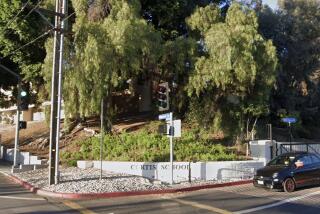Controversy Over Busing of Cudahy Pupils Resolved
- Share via
Parents angered over the busing of students from a school in Cudahy, where a tar-like seepage had forced a shutdown of the campus, announced Wednesday night an agreement with district officials whereby the children will attend classes closer to their homes.
The parents had objected to a Los Angeles Unified School District decision last month to send the children from Park Avenue Elementary School to a South-Central Los Angeles school seven miles away, where the parents feared gang violence.
Under the new agreement, announced in Cudahy City Park on Wednesday night by George Perez, head of the parents group, the students will continue to be bused to Russell Elementary School until September, when the regular school year begins. Then the students will move to classes in temporary bungalows and spare classrooms at Elizabeth School and Theresa Hughes School in Cudahy.
Perez said he was “very happy” with the agreement, but he said long-term problems, such as possible classroom crowding, still have to be resolved.
Ernie Delgado, a representative for school board member Leticia Quezada, and Maria Casillas, superintendent for Region B, which includes Park Avenue School, confirmed that the agreement had been hammered out by the parents and Casillas on Tuesday.
“I think it’s wonderful,” Casillas said. “I think it’s a good solution.”
Supt. Leonard Britton issued the order closing the year-round school after the Environmental Protection Agency took samples of the ooze. A preliminary study by independent consultant Angelo Bellomo indicated that the substance is a “complex mixture of hydrocarbons . . . highly acidic, like battery acid.”
Last December, a study by Thorne Environmental Inc. of Anaheim showed the seepage contained methylene chloride and phenathrene, potential carcinogens; methylnapthalene, which can cause headaches and mental confusion, and pyrene and benzopyrene, both carcinogenic and toxic.
Both reports indicated that the only danger to the students would come from eating the ooze, breathing the vapors if it were burned or having prolonged skin contact.
The school is built on an old landfill, and officials believe the seepage is from refuse and petroleum products dumped years ago.
More to Read
Sign up for Essential California
The most important California stories and recommendations in your inbox every morning.
You may occasionally receive promotional content from the Los Angeles Times.













